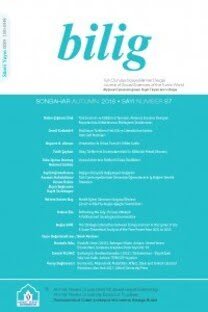Tuvacada Ad İşlevli Yancümleler ve Türkiye Türkçesindeki Eşdeğerlikleri
Complement Clauses in Tuvan and Their Counterparts in Turkish
Turkic languages, Tuvan, Altai Tuvan, syntax complement clauses,
___
Anderson, D. S. Gregory (2004). Auxiliary Verb Constructions in Altai-Sayan Turkic. Turcologica 51. Wiesbaden: Harrassowitz.Aydemir, İbrahim Ahmet (2002). “Attributive Nebensätze im Altai-Tuwinischen”. Scholarly Depth and Accuracy. A Festschrift to Lars Johanson. Yay. Nurettin Demir & Fikret Turan Ankara: Grafiker Yay. 39-50. ____ (2009). “Zum Aorist im Altai-Tuwinischen”. Turcological Letters to Bernt Brendemoen. Ed. Éva Á. Csató, Gunvald Ims, Joakim Parslow, Finn Thiesen and Emel Türker. Oslo: Novus Press. 21-29.
____ (2010). Türkçede Zaman ve Görünüş Sistemi. Ankara: Grafiker Yay.
Blühdorn, Hadarik (2008). “Subordination and Coordination in Syntax, Semantics and Discourse”. ʻSubordinationʼ versus ʻCoordinationʼ in Sentence and Text. A Cross-linguistic Perspective. Ed. C. Fabricius & W. Ramm. Amsterdam: John Benjamins Publishing Company.
Cristofaro, Sonia (2003). Subordination. Oxford: Oxford University Press.
Csató, Éva Á. (1999). “Modalität in Türkischen Komplementsätzen und ihre Entsprechungen im Deutschen”. Türkisch und Deutsch im Vergleich. Eds. L. Johanson & J. Rehbein. Wiesbaden: Harrassowitz. 23-32.
____ (2010). “Two Types of Complement Clauses in Turkish”. Turcology in Mainz/Turkologie in Mainz. Ed. Julian Rentzsch. Wiesbaden: Harrassowitz. 107-122.
Dixon, R. M. W. (2009). “The Semantics of Clause Linking in Typological Perspective”. The Semantics of Clause Linking: A Cross-linguistic Typology. Ed. Alexandra Aikhenvald & R.M.W. Dixon. Oxford: Oxford University Press. 1-55.
Erkman-Akerson, Fatma & Şeyda Ozil (1998). Türkçede Niteleme. Sıfat İşlevli Yan Tümceler. İstanbul: Simurg.
Göksel, Aslı & Celia Kerslake (2005). Turkish: A Comprehensive Grammar. London and New York: Routledge.
Harrison, K. David (2001). Topics in the Phonology and Morphology of Tuvan. PhD. Dissertation. USA: Yale University.
Isxakov, F. G. & A. A. Pal’mbax (1961). Grammatika tuvinskogo jazyka. Fonetika i morfologija. Moskva.
Johanson, Lars (1990). “Studien zur türkeitürkischen Grammatik”. Handbuch der türkischen Sprachwissenschaft 1. Ed. György Hazai. Budapest: Akadémiai Kiadó. 146-278.
____ (1991). “Zur Typologie türkischer Gerundialsegmente”. Türk Dilleri Araştırmaları: 98-110.
____ (1992). Strukturelle Faktoren in türkischen Sprachkontakten. Sitzungsberichte der Wissenschaftlichen Gesellschaft an der J. W. Goethe-Universität Frankfurt am Main 29: 5. Stuttgart: Steiner.
____ (1994). “Türkeitürkische Aspektotempora”. Tense systems in European languages. Eds. R. Thieroff & J. Ballweg. Tübingen: Niemeyer. 247-266.
____ (1998). “The Structure of Turkic”. Eds. Lars Johanson & Éva A. Csató. The Turkic Languages. London: Routledge. 30-66.
____ (2013). “Selection of Subjunctors in Turkic Non-Finite Complement Clauses”. bilig 67: 73-90.
Karakoç, Birsel (2002). “Nogayca ve Türkiye Türkçesinde Tümleç Yan Cümlelerinde Yüklemleştiriciler”. Scholarly Depth and Accuracy. A Festschrift to Lars Johanson. Yay. Nurettin Demir & Fikret Turan. Ankara: Grafiker Yay. 193-216.
Kerslake, Celia (2007). “Alternative Subordination Strategies in Turkish”. Connectivity in Grammar and Discourse. Eds. Jochen Rehbein, Christiane Hohenstein and Lukas Pietsch. Amsterdam and Philadelphia: John Benjamins. 231-258.
Lehmann, Cristian (1988). “Towards a Typology of Clause Linkage”. Clause Combining in Discourse and Grammar. Eds. John Haiman & Sandra A. Thompson. Albany, N.Y. Amsterdam: John Benjamins. 181-225.
Ölschlägel, Anett C. (2013). Der Taigageist. Berichte und Geschichten von Menschen und Geistern aus Tuwa. Zeitgenössische Sagen und andere Folkloretexte. Tectum Verlag: Marburg.
Rehbein, Jochen [Cristiane Hohenstein, Lukas Pietsch ile birlikte] (2007). “Connectivity as an Object of Linguistic Research in Multilingualism”. Connectivity in Grammar an Discourse. Eds. J. Rehbein & C. Hohenstein & L. Pietsch. Amsterdam: John Benjamins Publishing. 1-20.
Rentzsch, Julian (2013). “Türk Dillerinde Kipsellik ve Kipselliğin Anlambilimsel Haritası”. Bilig 67: 129–168.
Schönig, Claus (1998). “South Siberian Turkic”. The Turkic languages. Ed. Lars Johanson & Éva A. Csató. London: Routledge. 403-416.
- ISSN: 1301-0549
- Yayın Aralığı: Yılda 4 Sayı
- Başlangıç: 1996
- Yayıncı: Ahmet Yesevi Üniversitesi
Recaizade Mahmut Ekrem’in Atala Çevirisini Biçimlendiren Kültürel ve Estetik Kaygılar
Tuvacada Ad İşlevli Yancümleler ve Türkiye Türkçesindeki Eşdeğerlikleri
XIX. ve XX. Yüzyıllarda Osmanlı Basınında Çin Müslümanları ve Eğitimi
Türkiye ve Orta Asya Ülkelerinin Endüstriyel İş Döngüsündeki Karşılıklı Bağımlılığı
Türklerdeki Evren Anlayışının Mezopotamya Mitolojik Anlatımlarıyla Mukayesesi
“Tarihî Coğrafya” Yayın Değerlendirmesi Üzerine
İhvân-ı Safâ’nın Sanat Ontolojisi
Bilgehan GÜLCAN., Evren GÜCER., Kutay OKTAY, M.murat KIZANLIKLI
